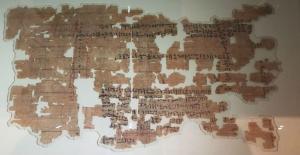Papyrus Brooklyn 35.1446 is an Egyptian seven foot long papyrus dating from 1809-1743 BC, and written in hieratic script, now in the Brooklyn Museum. Its time period includes the reign of Pharaoh Amenemhat III and the era of the 13th Dynasty, and it is one of the most important surviving administrative artifacts from the Middle Kingdom. This document names 95 household servants of a noblewoman named Senebtisi. At least thirty of the names are Semitic (Hebrew being a Semitic language), and several are plainly identifiable as Hebrew. I document nine of the latter below.
Following the timeline of Egyptologist Kenneth Kitchen (b. 1932), here are the proposed birthdates of biblical figures:
Abraham—born c. 1880–1860 B.C.
Isaac—born c. 1850–1820 B.C.
Jacob—born c. 1775 B.C.
Joseph—born c. 1737–1717 B.C. The Bible states that he was seventeen when sold into slavery (Gen. 37:2)
Thus, the document would overlap the lives of the biblical patriarchs Abraham, Isaac, and Jacob, and come within about six years of Joseph’s birth and roughly 23 years before the approximate date of Joseph being sold as a slave and winding up in Egypt (Gen 37:28). Joseph — after succeeding in Egyptian society and reaching high office (Gen 41:41) — brought his family there (Gen 45:18), who eventually wound up with many other Hebrews in the bondage of slavery (Ex 1:11). After some 500 years or so of slavery, the Hebrews spectacularly left Egypt in the Exodus, according to the Bible.
Bible skeptics (with whom we are always immeasurably blessed) disagree. Israeli archaeologist Ze’ev Herzog (b. 1941) wrote on 29 October 1999 in Haaretz: (“Deconstructing the walls of Jericho”):
This is what archaeologists have learned . . . the Israelites were never in Egypt, did not wander in the desert, did not conquer the land in a military campaign and did not pass it on to the 12 tribes of Israel. . . . Most of those who are engaged in scientific work in the interlocking spheres of the Bible, archaeology and the history of the Jewish people – and who once went into the field looking for proof to corroborate the Bible story – now agree that the historic events relating to the stages of the Jewish people’s emergence are radically different from what that story tells. . . . The many Egyptian documents that we have make no mention of the Israelites’ presence in Egypt . . .
Contrary to the above claim, this document offers compelling Egyptian documentary proof that there were indeed Hebrew slaves in Egypt during the time of Abraham, Isaac, and Jacob, and just before Joseph’s time. That is more than sufficient to refute Herzog’s foolish universal negative (“the Israelites were never in Egypt”).
The Hebrew names include “Menahema,” a feminine version of the Hebrew name “Menahem” (2 Kgs 15:14). Titus Kennedy (“Hebrews in Egypt before the Exodus? Evidence from Papyrus Brooklyn,” APXAIOC) describes several more:
. . . Ashera, a feminine form of Asher, the name of one of the sons of Jacob (Genesis 30:13); Shiphrah, the name of one of the Hebrew midwives prior to the Exodus (Exodus 1:15); ‘Aqoba, a name appearing to be a feminine form of Jacob or Yaqob, the name of the patriarch (Genesis 25:26); ‘Ayyabum, the name of the patriarch Job or Ayob (Job 1:1); Sekera, which is a feminine name either similar to Issakar, a name of one of the sons of Jacob, or the feminine form of it (Genesis 30:18); Dawidi-huat a compound name utilizing the name David and meaning “my beloved is he” (1 Samuel 16:13); Esebtw, a name derived from the Hebrew word eseb meaning “herb” (Deuteronomy 32:2); Hayah-wr another compound name composed of Hayah or Eve and meaning “bright life” (Genesis 3:20); and finally the name Hy’b’rw, which appears to be an Egyptian transcription of Hebrew (Genesis 39:14). Thus, this list is a clear attestation of Hebrew people living in Egypt prior to the Exodus, . . .
Archaeologist James K. Hoffmeier provides further analysis in his book, Israel in Egypt (Oxford University Press, 1996):
Since over forty Semites were attached to this single estate in the Thebaid, the number across Egypt, especially in the Delta, was likely considerable. . . . In the absence of any historical evidence for major military campaigns into the Levant by the Twelfth Dynasty monarchs, which would account for prisoners of war, Hayes suggests that there was “a brisk trade in Asiatic slaves carried on by the Asiatics themselves, with Egypt” not unlike that reported in Genesis 37:28, 36. . . .
Recently, a historical inscription of Amenemhet II (1901 – 1866 B.C.) has come to light which reports in campaigns into the Levant that results in the capture of 1,554 prisoners of war. . . . This same text also reports that Asiatic rulers and chieftains from Canaan sent individuals as tribute to the Egyptian court. (p. 61)
Kitchen adds:
As for Semites in Egypt (including as slaves), Redford has to admit to good evidence existing in all periods from the Middle Kingdom into the Late Period. But he is wrong in claiming that ownership of foreign servants was restricted to royalty and mainly the Late Period. Not so. . . . lesser households had them, too, as many private stelae clearly show then. Such foreigners came for trade, or as prisoners of war (slaves), also as slaves in tribute, or sold into Egypt as slaves (as under Amenemhat II). . . . There is sufficient Egyptian content in Gen. 37-50 . . . to indicate more than just a weekend trip to Egypt by some stray Hebrews at just any old period. (On the Reliability of the Old Testament [Grand Rapids and Cambridge: Wm. B. Eerdmans Publishing, 2003], p. 478)
***
Photo credit: Papyrus Brooklyn 35.1446 [Brooklyn Museum / “Semitic Slaves in Egypt”]
***
Summary: Papyrus Brooklyn 35.1446: a seven foot long document dated 1809-1743 BC, provides Egyptian proof of Hebrew slaves in that nation during the time of Jacob.














